Rebuilding NYCHA: A Fresh Look

David Schalliol, from Affordable Housing in New York
Over the past two decades the pages of New York City's dailies have been filled with a growing chorus of complaints about declining conditions in the New York City Housing Authority's vast system (178,000 apartments). Multiple reports by city officials, activists, and NYCHA's own metrics, have highlighted problems such as slow elevators, leaks, broken windows, delayed repairs, and unlocked lobby doors. Two decades of cutbacks have indeed reduced quality of life for residents when compared to the robust federal capital and operating funds of the 1990s. Fewer skilled staff, old buildings, higher energy costs, and late rents are just a few of the challenges faced by today's NYCHA administrators.
It is easy to lose sight, in the face of so much bad news, of the reason why New York has these maintenance problems while so many cities do not: NYCHA and city leaders are preserving large scale high-rise public housing against the national tide. Federal capital and operating subsidies, which continue to provide the bulk of NYCHA's revenues after rents, have been slashed. Most American big cities took the comparatively easier road of knocking down aging towers, even if it meant losing thousands of permanent, low-cost, subsidized apartments.
A new series of Geographic Information System (GIS) maps created by NYCHA document capital projects across the city and provide a revealing portrait of what is working today, and what still needs to be done, to upgrade "First Generation" NYCHA for the half a million New Yorkers who still live within its walls.
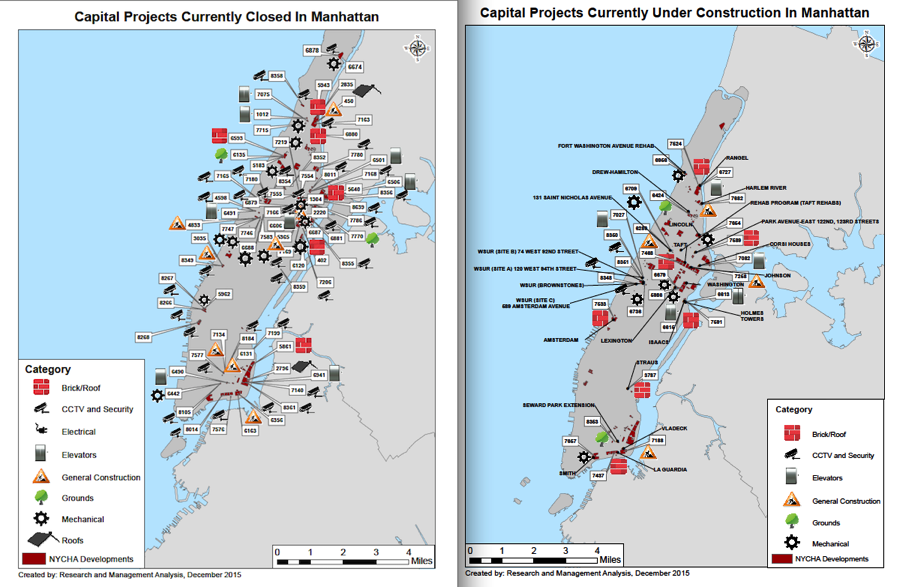
The maps, only a few of which are shown here, vividly illustrate that NYCHA is slowly rebuilding the thousands of aging towers in the system. The maps, and accompanying spreadsheets, indicate that many developments during the past decade or so have benefitted from new elevators, roofs, brickwork, parapets, electrical upgrades, security cameras, and updated mechanical systems.
NYCHA's Capital Projects Division oversees and designs the various projects, but private contracting firms, selected through a competitive bidding process, do the construction on a for-profit basis. Rebuilding NYCHA - where 400,000 New Yorkers live - is not just about housing, then, but it is also a public/private partnership that has pumped billions into the local economy. Hundreds of NYCHA residents have also gained work experience through these renovation projects.
The individual capital items are necessarily rendered as small icons on these maps but on the ground each icon represents a big and expensive undertaking because each individual NYCHA housing project is so large. A single icon on the map, for instance, usually involves multiple roofs, elevators, and brick repointing efforts at one project. These capital projects, moreover, are distinct from the millions of smaller repairs every year undertaken by NYCHA maintenance employees as part of everyday maintenance.
These large capital projects are not just being started, as the maps indicated, but also completed in a timelier manner than in the past. NYCHA has picked up the pace on its design, procurement, and contracting process. The NYC Stimulus Tracker, new staff and procedures, a recession (making NYCHA contracts more desirable for private construction firms that once dragged out the process), and public scrutiny are some of the factors in this speed up.
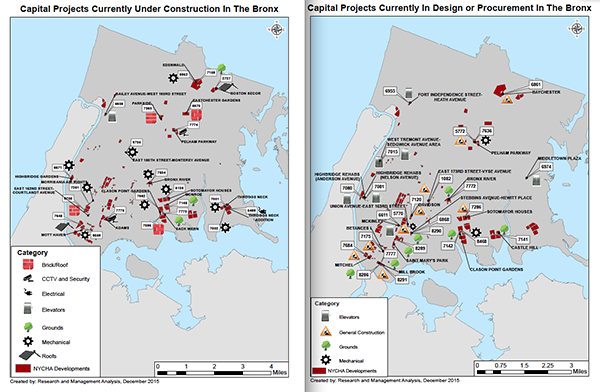
The maps also speak to baseline, long-term priorities: keeping out rain; delivering heat, electrical and water service; and installing safer elevators. The maps are thus full of roof, brickwork, parapets, and mechanical projects (plumbing, electric, and elevators) rather than apartment rehabilitation. Many residents, as reported in the newspapers, would likely prefer that NYCHA place an immediate emphasis on total apartment rehabs so that their lives improve now; the hundreds of thousands of monthly maintenance calls indicate a large, and possibly growing, number of defects per apartment.
From a long-term perspective, however, and in the current pinched budget situation, the strategy of securing building envelopes first makes sense. Expensive apartment rehabs, and even smaller patch jobs, often make good press, but they can be quickly undone, and often are, by a faulty heating pipe or leaky wall. Most NYCHA residents are therefore likely to remain dissatisfied with the state and number of defects in their aging apartments in the short term even with new roofs or brickwork protecting them in the years to come. Doing the right thing—using funds in a strategic way—thus remains politically risky when so much attention is focused on apartment repairs today.
This basic strategy of maintaining buildings envelopes is sound, but it is fair to say that even this prioritization of scarce resources is not guaranteed to secure NYCHA's future as a housing provider. NYCHA estimates that it needs an additional $17 billion in capital funds just for the next five years. A longer horizon on capital needs reveals an even larger capital need. Parsons Brinckerhoff, the global engineering and design firm, in 2011 estimated that NYCHA would face $30 billion in basic capital costs from 2011 to 2026—a figure far in excess of what was then or is currently available from city, state, or federal sources combined. When a roof project at Pink Houses costs over $37 million, an elevator project Roosevelt Houses demands $4 million, and brickwork at Glenwood Houses comes in at over $42 million—just a couple examples from hundreds—it is easy to see how NYCHA could still have billions in needed capital repairs over the coming decades. The cost of construction of all kind is expensive in New York and NYCHA is subject to both market pressure and federal labor regulations.
Were NYCHA to generate similar style maps using icons to show the additional major capital projects needed, these maps of needed work would be far more crowded than the maps of ongoing capital projects today. The required work for one housing project, Marble Hill Houses (1682 apartments) is provided as an example below of the amount of money that would be needed to upgrade just one project from top to bottom. The figures from the 2011 Physical Needs Assessment indicate that renovating Marble Hill to a good state would absorb a significant share of an entire year's worth of NYCHA's federal capital budget (to be spent system-wide) despite counting only about 1% of NYCHA's total apartments. Marble Hill's needs, moreover, are fairly typical for large NYCHA developments.
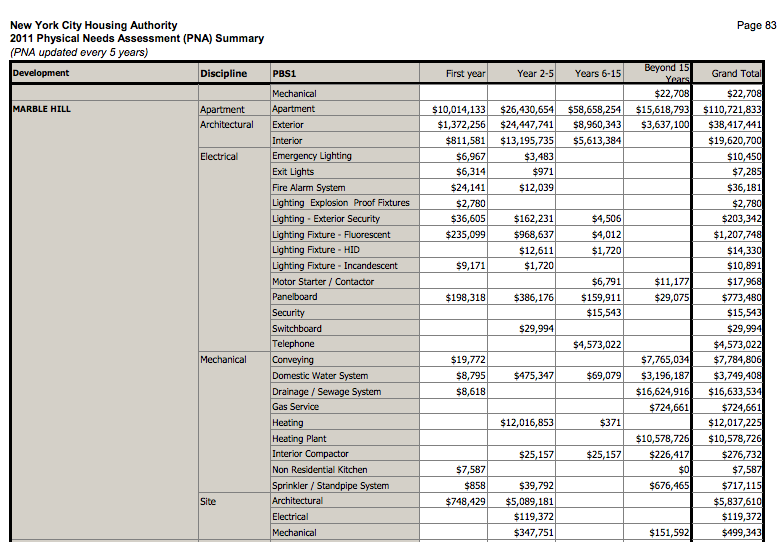
The maps and data sampled here answer many questions about what is being done to secure NYCHA's future, the locations of major projects, and what it costs to just partially rebuild America's largest public housing system. The maps do not, however, answer more worrisome questions about future funding and projects. This uncertainty is why NYCHA leaders continue to pursue new routes to renovation such as converting traditional public housing units to Section 8 and generating revenues from new market-rate housing on public housing grounds. Many solutions, and many big ones, are going to be needed to secure this housing for another generation.
*This is the first of a three-part series on NYCHA from Nicholas D. Bloom and partners*
Read part two: Goodbye to 'First Generation' NYCHA
Read part three: Looks Matter, Especially in Public Housing
***
Nicholas Dagen Bloom is Co-Curator of the current exhibition at the Hunter College, East Harlem Gallery, Affordable Housing in New York and Co-Editor of the anthology by the same name, available here.
***
Have an op-ed idea or submission for Gotham Gazette? Email This email address is being protected from spambots. You need JavaScript enabled to view it.
'New York Values' in Historical Perspective
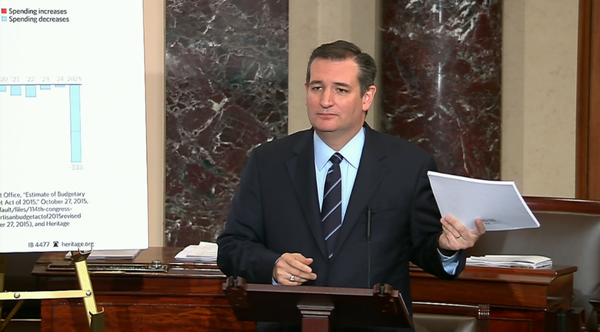
Ted Cruz (photo: @SenTedCruz)
Stereotyping New York in political debate
In a Republican presidential debate in January, Senator Ted Cruz tried to score points, saying of Donald Trump, "Donald comes from New York and he represents New York values." Cruz went on to say that "everyone in the country knows exactly what New York values are and I've got to say they're not Iowa values or New Hampshire values." New Yorkers are "socially liberal and pro-abortion and pro-gay marriage and focus on money and the media," he said.
Cruz repeated the message, with variations, in his campaigns in Iowa and New Hampshire.
Senator Cruz was using an old political gambit, playing on stereotypes of New York (particularly New York City) as excessively liberal, corrupt, money-grubbing, and out of step with the rest of America.
New Yorkers get their backs up when their city or state is stigmatized or attacked.
After the January debate, Governor Andrew Cuomo retorted that Senator Cruz "doesn't know what New York values are because New York is in many ways the epitome of what formed this nation and what keeps it strong....We do believe in E Pluribus Unum, out of many come one, and his rhetoric is the exact opposite." Several other prominent New Yorkers weighed in, including Donald Trump, who suggested that New York's heroic response to 9/11 revealed its deepest values.
Cruz's comments provoked many other New Yorkers to express their opinions (mostly positive) about their city. The New York Times asked a cross-section of city residents their opinion on what constituted "New York values" a few days after Cruz's attack. Their responses: New Yorkers are diverse, friendly, ambitious, curious, tolerant, competitive, impatient, hustling and determined -- "we keep our heads high, no matter what."
A New York Daily News front page on January 15 put it more directly with a headline of "DROP DEAD, TED."
New Yorkers have seen it before
Cruz is certainly not the first politician to try to cast New York as a place of wanton ways with values at odds with those of the rest of the nation.
Republican attacks on New York Governor Al Smith when he ran unsuccessfully for president in 1928 focused on his Catholic religion, opposition to prohibition, and subservience to the New York City Democratic organization Tammany Hall, all allegedly emblematic of his hometown, New York City. Smith's campaign theme song, "The Sidewalks of New York," and his "New York accent" in campaign speeches confirmed how ingrained New York City's culture and folkways were.
In 1960, conservative Republican Senator Barry Goldwater expressed a wish that "we could tell New York to kiss our [expletive] and we could really start a conservative party." In 1963, he suggested the nation would be better off if the east coast could be sawed off and floated out to sea. But everyone understood that New York, with its liberal politics, cultural influence and economic power, was his main bugaboo.
The next year, Goldwater won the Republican presidential nomination over New York Governor Nelson Rockefeller, whom Goldwater labeled a liberal New York spendthrift. His supporters sniped that Rockefeller was immoral for having divorced his first wife and remarried, something they vaguely insinuated had to do with loose New York morals.
Historical views of "New York values"
Fending off attacks is easier than defining precisely what New York's values are. That's no surprise, given New York's long history, complexity, and our proclivity for vigorous debate among ourselves.
In 1939, Mayor Fiorello LaGuardia assailed critics who asserted that his city was "a money mart...a synonym for Wall Street...New Yorkers are impolite." New York is "a warm-hearted and generous community," he insisted. But with a touch of that New York pride bordering on arrogance that can irritate outsiders, the mayor added that his city was so far superior to others that "we could afford to stop for the next twenty years and we would still be slightly ahead of the procession."
Historian Milton Klein wrote in 1978 that New Yorkers could be thought of as "cosmopolitan Americans: energetic...materialistic and brash but also convivial, humane, tolerant and idealistic. That one state alone should be able to encompass in itself so many of the virtues and limitations of the American people is a measure of New York's unique role in the nation's history."
Mayor Michael Bloomberg, in a statement to the 9/11 Commission in 2003, eloquently described his city's cosmopolitan pre-eminence:
To people around the world, New York City embodies what makes this nation great. That's a function of our status as the world's financial capital, driven not only by Wall Street but [also] our international prominence in such fields as broadcasting, the arts, entertainment and medicine. Such is New York's importance that to a great extent, as goes its economy, so goes the country's. If Wall Street is destroyed, Main Street will suffer. Beyond that, New York embraces the intellectual and religious freedom and cultural diversity that makes us truly the world's second home. We are a magnet for the talented and ambitious from every corner of the globe. In short, we embody the strengths of America's freedom.
Governor Mario Cuomo (1983-1995) saw enlightened, progressive public policies as New York's defining trait. He defined "the New York Idea" as "government using its resources to help create private sector growth, then requiring those who benefit from that growth to share some part of it so that hope and opportunity are extended to those who have not been as fortunate."
Andrew Cuomo, the current governor, emphasizes that New Yorkers are exceptionally energetic, innovative, determined, and resilient. "At every difficult moment in our nation's history, New York has emerged as...the progressive leader in the nation," he explained in his inaugural address in 2011. "In New York, we may have big problems, but we confront them with big solutions," he said in his State-of-the State message the next year. He often includes in his speeches a quotation from essayist E.B. White: "New York is to the nation what the white church spire is to the village, the visible symbol of aspiration and faith, the white plume saying the way is up."
Two sets of "New York values" seem to stand out
Of course, historians may differ on what New York's most important values are. But looking back over our history, two sets of values seem to stand out.
One is openness, inclusion, and tolerance. Since colonial times when the Dutch controlled the city, the emphasis has been on diversity, valuing individual differences, letting people alone, and providing opportunity for work, advancement, and getting ahead.
New York has been open, welcoming, accommodating, and supportive of newcomers. Over time, more immigrants have come in through New York than any other city. Our city and state have been at the forefront of social justice campaigns and civil rights reforms. For instance, the NAACP was founded in New York City in 1909 and New York passed the nation's first state civil rights law, in 1945. New York City probably has the most diverse population of any major city in the world.
A second is optimism and resilience. New Yorkers are undeterred by setbacks, springing back from adversity and continuing forward progress. It dates back at least to the origins of the state. The Revolutionary New York provincial congress were rebels-on the run, moving from New York City to White Plains to Fishkill to Kingston ahead of advancing British troops. They finished hastily drafting New York's first state constitution in April 1777.
When the British threatened Kingston, the new government became a government-on-the run, simply dispersing, reassembling later at Poughkeepsie, and keeping the fledgling state intact. The first governor, George Clinton, calmly took the oath of office in August 1777 and then hurried off to lead a battle against the enemy where he barely escaped capture.
New Yorkers keep going and are known for against-the-odds triumphs. For instance, mockery and stonewalling by the power structure inspired New York's great women's rights advocate Elizabeth Cady Stanton on to more tenacious campaigning. Denied the right to vote, she defiantly ran for Congress from New York City in 1868, losing but making a point about women's political stature. Jackie Robinson was undeterred by racist taunts and threats and became the first black man to play professional baseball, with the Brooklyn Dodgers in 1947, and later an inspirational civil rights leader.
The New York City Fire Department mourned its dead after 9/11 and then got right back to work, creatively revising its mission, policies, and training to meet the new threat of terrorism.
New York City not only survived the attacks but came back more resilient and stronger than ever.
The debate over "New York values" is likely to continue
New York mirrors the nation in its complexity and resists tidy categorization. Its values are hard to pin down but its history is rightly a source of inspiration and pride, with tolerance and resilience at the core.
Activist, writer, and New York City First Lady, Chirlane McCray, refuted Ted Cruz by citing the city's steadfastness in challenging times."That fighting spirit, that gut instinct to join together in times of hardship, that refusal to leave behind the most vulnerable among us -- these are the values that have defined New Yorkers from the very beginning."
As the presidential campaign moves along, we can expect to hear more about "New York values." When we do, we need to keep historical insights and perspectives in mind.
***
Dr. Bruce W. Dearstyne lives in Guilderland, New York. He is the author of The Spirit of New York: Defining Events in the Empire State's History, published in 2015 by SUNY Press.
***
Have an op-ed idea or submission for Gotham Gazette? Email This email address is being protected from spambots. You need JavaScript enabled to view it.
'Making A Murderer' Flaws All Around Us
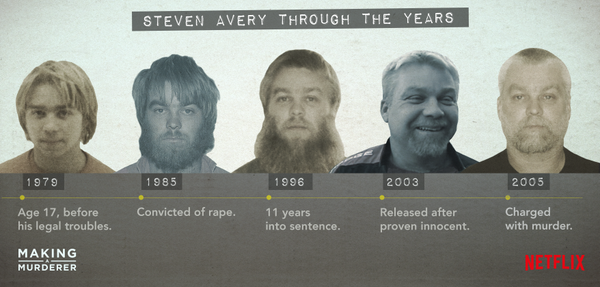
photo via Making A Murderer on Twitter
The Netflix documentary "Making A Murderer" challenges the moral core of our criminal justice system: that the police and prosecutors are objective and unbiased. The film follows Steven Avery, a Wisconsin man who spent 18 years in prison for rape before being exonerated, then arrested for murder two years later, found guilty, and sentenced to life in prison. The highly questionable police methods—a key piece of evidence miraculously appears; an improbable confession is coerced from a developmentally delayed adolescent—and the glaring conflicts of interest of many of the participants will infuriate any fair-minded viewer.
The criminal justice system's legitimacy is founded on our secular faith in unbiased police-work, forensic science, and truth-seeking prosecutors. However, many of these pillars are structurally unsound, as supported by reams of scientific studies and the wisdom of leading observers.
The problems with forensic science were first exposed systematically in a National Academy of Sciences report in 2009, but the legal system has been slow to incorporate its findings. Official misconduct of the type suggested in Making A Murderer is not isolated to small towns in Wisconsin. Alex Kozinski, one of America's foremost jurists and scholars, and a judge on the United States Court of Appeals, has recently written an opus which probes these problems in depth. And Kozinksi is no liberal; he was appointed by Ronald Reagan.
Take confessions. It is unfathomable to most of us, but it is not unusual for people under duress to confess to crimes they did not commit. And for minors sweating under the bright lights, their inherent anxiety and propensity for pleasing authorities, coupled with the various ruses, all legal, which the police can employ, render them easy prey. New Yorkers cannot forget that the Central Park Five (teenagers at the time) falsely confessed and spent several years in prison before being exonerated.
Eyewitness testimony is also subject to manipulations and the plasticity of human memory. In Steven Avery's first case the victim mistakenly identified him, after several inappropriate prompts from the police. And misidentification is even more likely when victims and perpetrators are of different races, an expected occurrence in multicultural communities like New York City. A New York State Bar Association study found misidentification to be the leading cause of wrongful convictions. Numerous expert panels have outlined model procedures for police to use when investigating eyewitness testimony and the NYPD should incorporate these findings.
High tech forensic science, despite its aura of infallibility, is less than perfect and many familiar methods have been tossed on the junk pile. Bite mark analysis, arson science, fiber and hair analysis, are among those that are now discredited as completely lacking in scientific validity. The Justice Department and FBI have acknowledged that evidence presented by an elite forensic unit over a two-decade period was based on methods now recognized as invalid.
The Manhattan District Attorney's office is, however, disregarding the scientific consensus and fighting tooth and nail to continue using bite mark evidence. In contrast, the new Brooklyn District Attorney, Ken Thompson, recently moved to have an arson-murder conviction overturned, in part due to now discredited "arson science," and Mr. Thompson's office is garnering national attention for its commitment to review cases and rectify wrongful convictions.
To a prosecutor, the most important bit of data is his or her conviction rate, and the resultant zeal to convict at all costs detours our system away from objectivity towards something like a witch hunt. Prosecutors routinely withhold exculpatory evidence from the defense. As Justice Kozinski puts it, "there is an epidemic of Brady violations [duty to disclose any vital evidence] in the land."
According to the National Registry of Exonerations, official misconduct was a factor in 45% of false convictions. In Orange County (CA) the district attorney's office is rocked with scandal after revelations that the police and prosecutors colluded in a decades long campaign of frame-ups and perjury. And in Brooklyn, as noted above, the new district attorney has begun dealing with the fallout from years of dubious tactics used by his predecessor, Charles Hynes.
This short list of prosecutorial abuses and junk science is only a glimpse at the problem. To give some depth, consider that one study in a prestigious journal estimated that 4.1% of all persons on death row could be exonerated. With roughly 3,000 people on death row now, about 120 persons sentenced to die may be innocent. If this rate of wrongful convictions is extended to the 1.5 million persons in federal and state prisons, 61,500 persons could be declared innocent, set free, and have their criminal records erased.
Though Steven Avery was not rich he had a competent defense team, yet still could not prevail (I am not claiming he is innocent, but that his trial was a travesty and he should not have been found guilty based on its proceedings.) But for poor people who cannot afford a private attorney, woefully understaffed and underfunded public defenders are their only option. That is why innocent people take plea bargains; without an effective defense they have no chance of winning. According to the National Registry of Exonerations, 10% of exonerees pleaded guilty, despite their innocence, to avoid a trial.
There is already a broad consensus that we send too many people to prison, for too long, and for behavior (e.g., drug use, sex work, nuisance offences) that should not be criminalized. Beyond that, we must ensure that police and prosecutors use valid methods to gather evidence and present that against the accused. The public election of prosecutors must be revisited to avoid the sort of uncontested transfer of power that occurred in the Bronx last year.
Finally, the New York State Court system recently issued rules enabling video recording of courtroom proceedings and these should be interpreted as liberally as possible to ensure that a Making A Murderer type of injustice can't happen here.
***
Christopher Beall works at a criminal justice nonprofit in the Bronx and is on Twitter @JailedintheUSA.
***
Have an op-ed idea or submission for Gotham Gazette? Email This email address is being protected from spambots. You need JavaScript enabled to view it.




